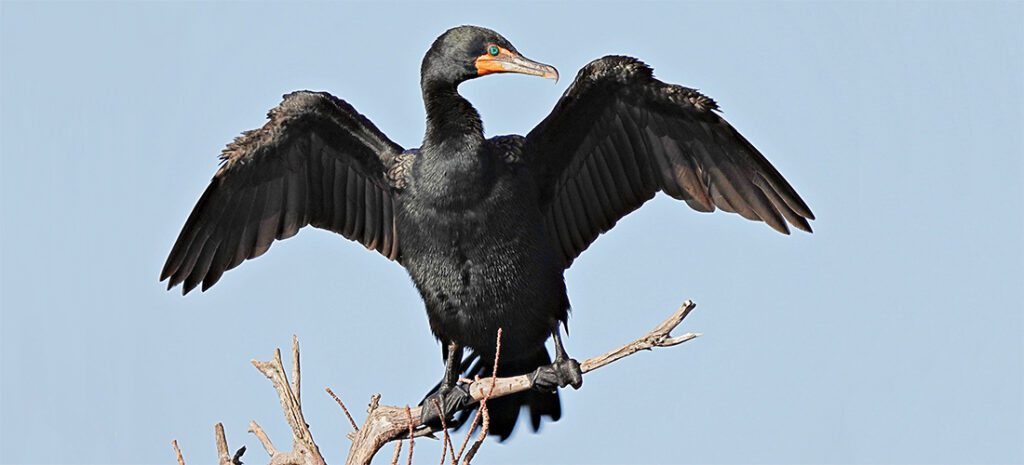Birdwatch

Flying Under the Radar
The rarely noticed double-crested cormorant
By Susan Campbell
Overlooked by many, the double-crested cormorant is a waterbird found alone or in small groups across our state during the cooler weather. This large, black, gull-like bird has few admirers. It only gets noticed when sitting with wings outstretched, drying in the sun, on an exposed perch such as a low snag or bulkhead. Although cormorants are less waterproof than most, their lack of buoyancy makes it easier to swim after prey in deep water. They can be found in a variety of bodies of water, from retention or farm ponds to larger lakes and reservoirs. However, if you are at the beach during the winter months, you may see them in the open ocean, often foraging together by the thousands.
This bird is hardly a striking waterbird. Cormorants actually look odd — somewhat like a cross between a loon and a goose. Although it seems to be a dull black bird with a long neck and pointed wings, should you see it at close range it actually does sport some color. The bright orange-yellow facial skin and shockingly aquamarine eyes of adult birds are apparent. Furthermore, breeding individuals have two black and white tufts as well as a blue mouth from early spring through mid-summer.
Double-crested cormorants are widely distributed across North America. They breed on rocky outcroppings off the coast of Canada and Alaska as well as on islands in wetter portions of the Upper Midwest. They place bulky nests in stout trees or on the ground in colonies. Flocks migrate inland across the United States to coastal wintering sites. Some cormorants can be found farther away from the coast in wetter habitats of the Southeast.
Given that this species primarily feeds on a variety of fish, and can congregate in large numbers, it is sometimes considered a nuisance by fish farmers and fishermen. Double-crested cormorants have strongly hooked bills which, along with their strong, webbed feet, definitely make them good fishers. More often than not, however, their foraging goes unnoticed, especially here in North Carolina. Moving from place to place, like so many species of birds, they form skeins or V-formations. Significant flocks have been known to show up during the fall in the Sandhills. Flying low, they appear in the afternoon to drop in to feed on one of our larger lakes. Just before dark they will fly up into an older pine to roost.
It is hard to believe that double-crested cormorant populations were once imperiled. Widespread use of pesticides in the 1960s and ’70s impacted the breeding success of many birds, especially those high up on the food chain. Compounds such as DDT caused eggshell thinning and thus, a precipitous decline in breeding productivity until it was banned in the U.S. in 1969. Recovery was swift, however, and numbers remain high in spite of increased human activity throughout the species’ range. PS
Susan Campbell would love to hear from you. Feel free to send questions or wildlife observations to susan@ncaves.com.
